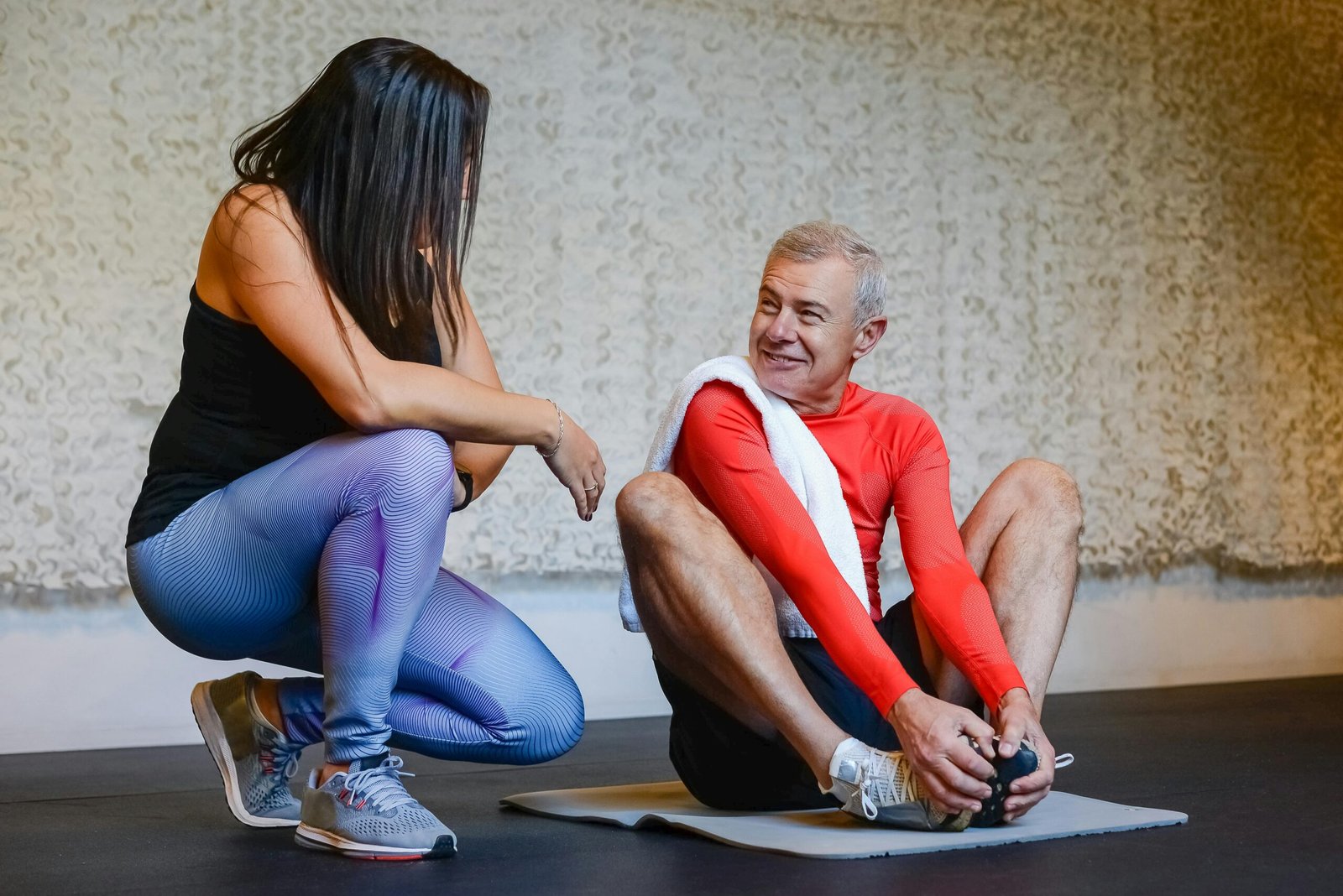I. Introduction
Understanding the Goal
Fat Loss Without Muscle Loss: Lose fat maintain muscle is a common fitness goal that requires a strategic approach combining nutrition, exercise, and recovery. The main objective is to create a caloric deficit to lose fat while ensuring sufficient protein intake and resistance training to preserve muscle mass. This balance is crucial because losing muscle can lower metabolism and make it harder to keep the fat off in the long run.
Understanding this balance helps set realistic goals and expectations. It’s important to recognize that rapid weight loss often leads to muscle loss, so patience and consistency are key. By prioritizing both aspects equally, you can achieve a lean, toned physique without sacrificing strength and functionality.
Importance of Balancing Fat Loss and Muscle Preservation
Balancing fat loss and muscle preservation is essential for maintaining overall health and fitness. Muscle tissue is metabolically active, meaning it burns calories even at rest, helping you sustain a healthy weight. Additionally, muscle strength contributes to better physical performance, reduced injury risk, and improved quality of life.
Focusing solely on fat loss can lead to a decrease in muscle mass, resulting in a slower metabolism and potential weight gain. By maintaining muscle, you not only achieve a more aesthetic look but also support long-term health and well-being. This holistic approach ensures that your weight loss journey is sustainable and beneficial beyond just aesthetics.
II. Nutrition

Caloric Intake
Creating a caloric deficit is the foundation of fat loss. To lose fat while preserving muscle, it’s crucial to consume fewer calories than you burn. However, the deficit shouldn’t be too extreme, as drastic calorie cuts can lead to muscle loss and other health issues. Aim for a moderate deficit of 500–700 calories per day, which generally results in a safe and sustainable weight loss of about 1-2 pounds per week.
Tracking your caloric intake can help ensure you’re not under-eating or over-eating. Use a food diary or a tracking app to monitor your daily intake and adjust as needed. Remember, the goal is to fuel your body adequately while promoting lose fat maintain muscle.
Macronutrient Balance
Maintaining a proper balance of macronutrients—protein, carbohydrates, and fats—is vital for losing fat and preserving muscle. Protein is the most crucial macronutrient for muscle maintenance. Aim to consume about 1.2 to 2.2 grams of protein per kilogram of body weight daily. This protein intake supports muscle repair and growth, especially when combined with resistance training to lose fat and maintain muscle.
Carbohydrates are essential for providing energy during workouts and aiding in recovery. Include complex carbs like whole grains, vegetables, and legumes in your diet. Fats are also necessary for overall health, supporting hormone production and nutrient absorption. Focus on healthy fats from sources like avocados, nuts, seeds, and olive oil.
Meal Timing
When you eat can be as important as what you eat. Meal timing, particularly around workouts, can significantly impact muscle preservation and fat loss. Consuming a balanced meal with protein and carbohydrates before your workout provides the energy needed for optimal performance. A post-workout meal or snack helps replenish glycogen stores and promote muscle recovery.
Eating small, frequent meals throughout the day can help maintain energy levels and prevent overeating. Ensure that each meal includes a balance of protein, carbohydrates, and fats to support your overall goals. By strategically timing your meals, you can enhance your body’s ability to lose fat and preserve muscle.
III. Exercise

Strength Training
Strength training is paramount for maintaining muscle mass while losing fat. Incorporate resistance exercises targeting all major muscle groups at least 3–4 times per week. Exercises like squats, deadlifts, bench presses, and rows are effective for building and maintaining muscle. Use a combination of free weights, machines, and bodyweight exercises for variety and effectiveness.
Progressive overload, where you gradually increase the weight or resistance, is key to stimulating muscle growth. Ensure your training program is challenging enough to push your muscles to adapt and grow. Rest and recovery between sessions are equally important to allow muscles to repair and strengthen.
Cardio
Cardio exercise plays a crucial role in burning calories and promoting fat loss. However, excessive cardio can lead to muscle loss. To balance fat loss with muscle preservation, incorporate moderate amounts of cardio into your routine. Aim for 150–300 minutes of moderate-intensity cardio or 75–150 minutes of high-intensity cardio per week.
Low-impact cardio options like cycling, swimming, or brisk walking can help burn calories without placing excessive stress on your muscles. Integrating cardio with strength training ensures you achieve a leaner physique while maintaining muscle mass.
High-Intensity Interval Training (HIIT)
HIIT is an effective method for burning fat while preserving muscle. HIIT involves short bursts of intense exercise followed by brief recovery periods. This training style boosts your metabolism, leading to greater fat loss in a shorter amount of time compared to steady-state cardio.
Incorporate HIIT sessions 1-2 times per week. Exercises like sprints, jump squats, and burpees can be used in HIIT workouts. HIIT not only helps in losing fat but also enhances cardiovascular fitness and overall endurance. Remember to balance HIIT with strength training and proper recovery to avoid overtraining and muscle loss.
IV. Recovery

Rest and Sleep
Rest and sleep are critical components of any fitness plan, especially when aiming to lose fat and maintain muscle. During sleep, your body repairs and builds muscle tissue, and adequate rest ensures that your workouts are effective. Aim for 7-9 hours of quality sleep per night to support muscle recovery and overall health.
Chronic sleep deprivation can lead to increased levels of the stress hormone cortisol, which can promote fat storage and muscle loss. Create a sleep-friendly environment by keeping your bedroom cool, dark, and quiet, and establish a regular sleep schedule. Prioritizing rest and sleep helps maximize the benefits of your diet and exercise efforts.
Active Recovery
Active recovery involves engaging in low-intensity activities on rest days to promote blood flow and aid in muscle repair without overloading the body. Activities like yoga, stretching, or leisurely walks can help alleviate muscle soreness and improve flexibility.
Active recovery can also include techniques like foam rolling or light swimming. These activities enhance circulation, reduce muscle stiffness, and accelerate the recovery process. By incorporating active recovery, you support muscle maintenance and ensure your body is ready for your next workout session.
V. Supplements

Protein Supplements
Protein supplements can be a convenient way to ensure you’re meeting your daily protein needs, especially if you have a busy lifestyle. Whey protein, casein protein, and plant-based protein powders are popular choices. These supplements provide high-quality protein that aids in muscle repair and growth.
Use protein supplements as a complement to your diet, not a replacement for whole foods. Consuming a protein shake post-workout can help kickstart the recovery process. Additionally, protein supplements can be useful for meeting protein targets when meal planning is challenging.
Other Supplements
Apart from protein, several other supplements can aid in fat loss and muscle maintenance. Branched-chain amino acids (BCAAs) help reduce muscle soreness and promote muscle retention during calorie deficits. Creatine is another supplement that enhances strength and muscle mass, making it beneficial for both performance and muscle preservation.
Multivitamins ensure you’re getting essential nutrients that might be lacking in your diet. Omega-3 fatty acids support overall health and can reduce inflammation, aiding recovery. While supplements can be beneficial, it’s important to prioritize a balanced diet and consult with a healthcare professional before starting any new supplement regimen.
VI. Tracking Progress

Measuring Fat Loss
For lose fat maintain muscle.Tracking your progress is essential to ensuring you’re on the right path to losing fat and maintaining muscle. Use multiple methods to measure fat loss, such as body weight, body measurements, and body fat percentage. Progress photos can also provide a visual representation of changes over time.
Regularly assess your progress to determine if adjustments are needed in your diet or exercise routine. Keep in mind that weight fluctuations are normal and focus on long-term trends rather than daily changes. Consistent tracking helps you stay motivated and make informed decisions about your fitness journey.
Monitoring Muscle Mass
Monitoring muscle mass is crucial to ensuring you’re maintaining or building muscle while losing fat. Use methods like muscle circumference measurements, strength benchmarks, and body composition analysis to track muscle mass. Regularly assess your strength levels to ensure you’re not losing muscle.
Strength training performance is a good indicator of muscle maintenance. If you notice a decline in strength, it may be necessary to adjust your nutrition or training program. Consistent monitoring helps you stay on track and make the necessary adjustments to achieve your goals.
VII. Common Challenges and Solutions

Plateaus
Plateaus are a common challenge in any fitness journey. They occur when progress stalls despite continued efforts. To overcome plateaus, consider adjusting your caloric intake, changing your workout routine, or increasing the intensity of your exercises.
Sometimes, incorporating a refeed day or a short diet break can help reset your metabolism and break through a plateau. Stay patient and persistent, and remember that plateaus are a normal part of the process. Regularly assess your progress and make strategic changes to continue progressing.
Maintaining Motivation
Staying motivated throughout your fitness journey can be challenging. Set clear, achievable goals and track your progress to stay motivated. Celebrate small victories along the way and remind yourself of the benefits of losing fat and maintaining muscle.
Having a workout buddy or joining a fitness community can provide support and accountability. Additionally, varying your workouts and trying new activities can keep things interesting and prevent burnout. Stay focused on your long-term goals and remember why you started your journey.
VIII. Long-Term Maintenance

Sustainable Habits
Achieving and maintaining a lean, muscular physique requires adopting sustainable habits. Focus on creating a balanced, healthy lifestyle rather than short-term fixes. Incorporate regular physical activity, balanced nutrition, and adequate rest into your daily routine.
Avoid extreme diets or workout programs that are not sustainable in the long term. Instead, make gradual changes that you can maintain. Sustainable habits ensure that your results are long-lasting and that you continue to enjoy the benefits of your hard work.
Periodic Adjustments
Regularly reassessing and adjusting your nutrition and exercise plan is important for continued progress. As you lose fat and build muscle, your body’s needs will change. Periodically evaluate your goals, progress, and lifestyle to make necessary adjustments.
Adjustments might include modifying your caloric intake, changing your workout routine, or incorporating new activities. Staying flexible and open to change ensures that you continue to challenge your body and achieve your fitness goals. Regularly consulting with a fitness professional can provide valuable insights and guidance.
IX. Conclusion

Recap
Losing fat while maintaining muscle is a multifaceted goal that requires a balanced approach. By focusing on proper nutrition, effective exercise, adequate recovery, and regular progress tracking, you can achieve a lean, strong physique. Remember to set realistic goals, stay consistent, and prioritize long-term health and well-being.
Encouragement
Embarking on a journey to lose fat and maintain muscle is challenging, but the rewards are worth it. Stay motivated, be patient with yourself, and celebrate your progress along the way. Your dedication and effort will lead to lasting results and improved overall health.
Resources
For further guidance, consider consulting with fitness professionals, nutritionists, and online resources. Books, apps, and fitness communities can provide additional support and information. Equip yourself with knowledge and stay committed to your goals for continued succes



